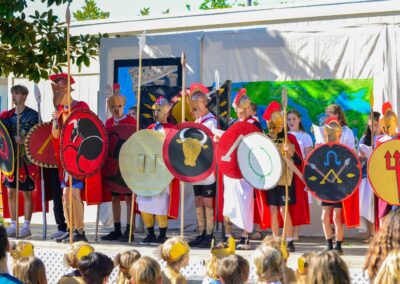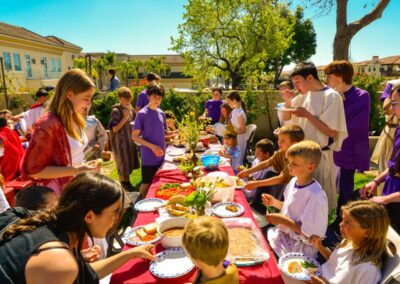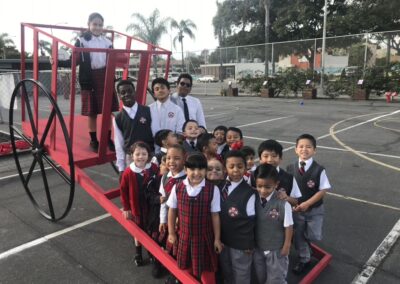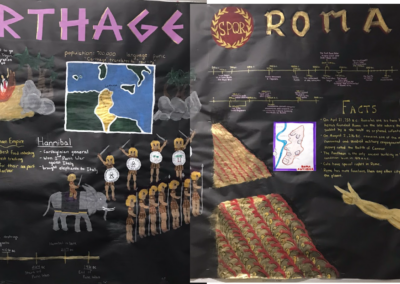The Historical and Incarnational Possibilities of Year End Celebrations
A joyous Eastertide! As the academic year is drawing to a close, many schools offer celebrations as a way to draw the community together one last time before summer vacation begins. It is to punctuate the year with an exclamation point! Yet, is there something more to these celebratory year-end gatherings at our liberal arts schools that goes even deeper than the lovely display of the culmination of the students’ hard work and the bidding of farewell? We believe so.
In the Catholic liberal arts tradition, schools have taken The Holy See’s Teaching on Catholic Schools’ directive that the education program be “imbued with a Catholic worldview throughout the Curriculum” with history in mind. We understand that history is in fact salvation history. It is His Story, to be told and retold across the years at every grade level! This is a beautiful way for schools to incarnate God’s becoming Man in a time-honored fashion. As Christ’s story becomes the central figure in our children’s own life stories throughout their education and upbringing, schools do well to recreate His Story throughout the years. They do this through the means Christ Himself modeled: through time (history) and the beauty of incarnation (method).
In many of our member schools, history is often divided into four distinct eras of study centered on the Incarnation– those centuries leading up to the Birth of Christ (Ancient civilizations including Greece and Rome), the Incarnation itself and spread of Christianity (the fall of Rome, early Christendom and the Middle Ages), the latter time periods following the spread of Christianity (the Renaissance, Reformation and Counter-reformation), and lastly, the Age of Discovery and the Modern Era.
Christ’s Incarnation is present when we learn any truth. To incarnate a truth is to embody it, to know it so deeply that the truth itself is inextricably bound to our minds, hearts, and souls. Likewise, how we end the school year as a community can and should be an act of embodiment. When we take time to celebrate the culmination of our academic year with expressions, productions, and incarnations of the truths learned, we are giving children something for their souls to embody, and therefore, remember. Indeed, we imitate Jesus’ words at the Last Supper, “Do this in memory of me.”
What are some of these ways our students embody their learning, and therefore celebrate, remember, and rest in an imitation of the Incarnation of Christ? Plan an annual spring celebratory event! The whole school attends with their families, and students shine in representing their hard-earned wisdom at the year’s end. Begin with a promenade of students in costume representing each grade level’s historical time period. For individual classroom presentations, here are some embodied examples with different time periods and age levels in mind:
- Ancient History, Greece, and Rome: An ancient Egyptian museum or feast; A Greek god/goddess wax museum; a reenactment of the Trojan War, a performance of scenes from Shakespeare’s Julius Caesar; an evening of recitations from Greek literature by individual students.
- The Birth of Christ and Early Christendom to early Middle Ages: A Byzantine Art museum; reenactments of the Nativity and Passion of Christ; a wax museum of cultures/countries representing the spread of the Gospel; reenactments of Monastic life; a concert in Gregorian Chant; recitations and presentations of lives of the saints from the time periods under study.
- Later Middle Ages; the Renaissance, Reformation & Counter-Reformation: medieval reenactments; a Renaissance art imitation museum; a staged debate among key people from the Reformation and Counter-Reformation, a reenactment of the Council of Trent; recitations and presentations of lives of the saints (e.g., St. Ignatius of Loyola, St. Teresa of Avila); Battle of Lepanto reenactment.
- The Age of Discovery, Enlightenment, and the Modern Era: a museum or speech festival of scientists and inventors; a staged debate of Enlightenment philosophers; reenactments from the American and French Revolutions; a timeline concert of classical music (i.e., renaissance, baroque, classical, romantic); recitations of famous speeches, poetry, and literature; an art gallery walk of imitations of the greats of this time period,; a timeline performance of dance (quadrille, waltz, cotillion, foxtrot, swing).
End the school year with incarnation and bestow upon students the embodiment of Christ’s story in all its glory across the centuries at your school!









